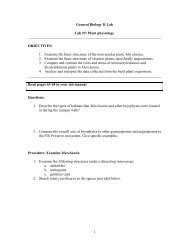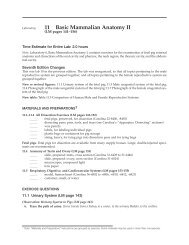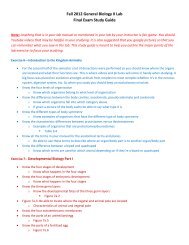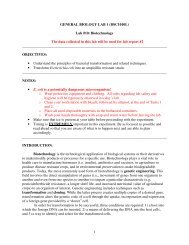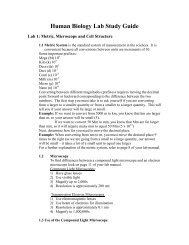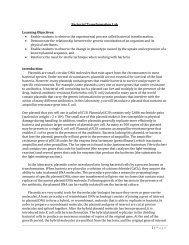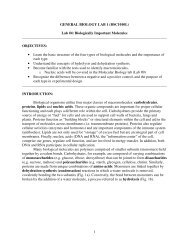Exercise 3: Membranes
Exercise 3: Membranes
Exercise 3: Membranes
Create successful ePaper yourself
Turn your PDF publications into a flip-book with our unique Google optimized e-Paper software.
22. (a)Is your null hypothesis or alternative hypothesis supported by your data? Explain. (b) Doyou reject or fail to reject your null hypothesis?23. If person’s blood volume drops due to injury or sever dehydration, why do doctorsadminister isotonic saline intravenously instead of pure water?24. What osmotic regulatory challenges would a fish living in freshwater have versus a fishliving in salt water?Task 6: OsmoregulationOsmosis is the transport of water through a semi-permeable membrane down itsconcentration gradient. Osmosis is responsible for the fluid transport out of the kidney tubules andgastrointestinal tract, into capillaries, and across cell membranes. Tonicity classifications arerelative terms describing the concentration of one environment to another. Hypertonic solutionscontain a higher solute concentration than a compared solution. When concentrations are the samebetween both solutions, they are isotonic. Hypotonic refers to a solution that has a lower soluteconcentration than the solution on the opposing side of the membrane.Organisms maintain homeostasis through osmoregulation, the active regulation of theosmotic pressure of their fluids. Osmotic pressure comes from the ability of a solvent and theinability of a solute to pass through a semi permeable membrane. When cells are placed in extremeenvironments, drastic effects on the cells can be observed. Sheep’s red blood cells lyse when placedin a hypotonic solution, a process called hemolysis. When plant cells are placed in hypertonicsolutions plasmolysis occurs. This process involves the loss of water through osmosis, whichcauses the plant’s plasma membrane to pull away from the cell wall. Today you will subject livingcells to environments with different concentrations of a solute and observe their responses.Directions: In the table below, predict the reaction of the following cell types in the differentenvironments.14



